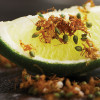
THE BENEFITS OF LOCAL
Mikey says people should strive to know where their produce and ingredients come from. For him, locality is about asking yourself the what, where, when, and how behind the ingredients you use. “The short and simple of it is, buying local not only tells you where it’s come from, it gives you more control over quality. This ensures less double handling and middlemen – which potentially leads to extra packaging and travel costs. Lastly, and for me, most importantly, you are connecting with the community and building business in your neighbourhood.”
MAKING MORE WITH LESS
On an industry level, Mikey notes that while local produce and ingredients may not always be the cheapest for businesses, they are often of a better quality. “We try and focus on the potential of that product’s second use or third use. This makes the initial cost a little less daunting, as you know you can prepare two or even three items from the same product.” He cites the use of lemon in bars as an example. “Classically, we juice them fresh or cut them for garnish. We can take the lemon shells after juicing and produce a number of things, from citrus stocks that can in - turn cut down your citrus use in drink, to citrus acid packs and cordials. You could also take your leftover cut garnish lemon and add them to sugar to extract the oils, leaving you a delicious fresh citrus honey or syrup."
NEW ZEALAND GIN
Mikey has enjoyed seeing the rise of native botanicals being used in New Zealand craft gins and believes it’s a great way to showcase local flavours. “We have a very unique climate, which gives a pretty different flavour profile to the classic gin botanicals – especially in the citrus department. There is word of some juniper projects going on as well, which will be interesting to see what our terroir brings to the table.” Though he adds, “There are some great products out there shaping this market. I just hope it doesn't get saturated on a local scale as we are so small.”
INTRODUCING LOCAL ELEMENTS TO GIN DRINKS
“I use a lot of native herbs and root vegetables,” says Mikey on using local ingredients, such as garnishes, in gin-based drinks. “Lately, I have been playing with nettles, gorse, sorrel, and hops, quite a lot. The likes of purple kumara, horopito [New Zealand pepper tree], Kawakawa [also a pepper tree] are all relatively easy to find or get your hands on – whether you pick them yourself or buy them in tea format, which is becoming more popular.” Mikey notes that the treatment of the ingredients will differ and is very much on “a case-by-case” basis. For example, many green leafy ingredients benefit from being dried out and then rehydrated, either in water as a tea or in a spirit as an infusion. While for ingredients like gorse flowers and kumara, often dabbling in some fermentation is a good option.“Gin, in general, is a great carrier of flavour and helps to build a solid backbone to a drink. Often, the addition of extra botanical is beneficial, but be careful, for me, less is more,” Mikey says. He adds, while “there's a whole heap of native plants and produce that you can play with,” it’s essential to do your research. “Always read up about the ingredients you intend to use, also how they should or have been treated before.” How can you better understand the flavours that make up a craft gin? Mikey says: “Read the labels, understand the botanicals, but most of all, taste it by itself first before you throw it into a highball with tonic or in your favourite drink.
Share this post:






